Siemens MC35 User Manual
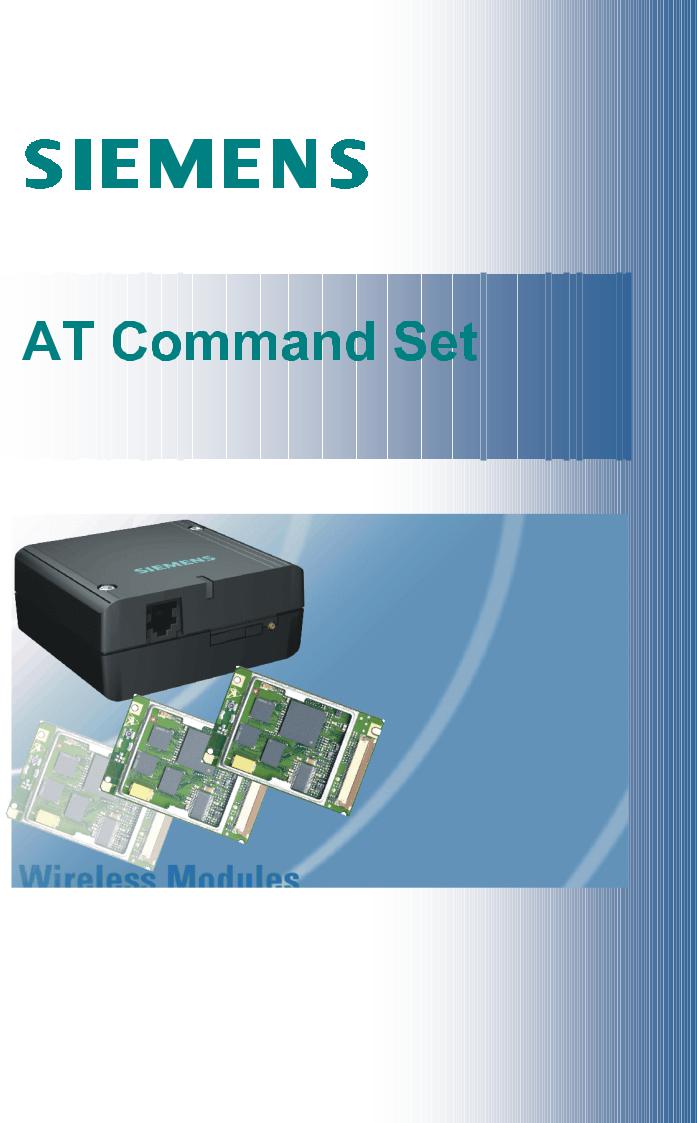
Siemens Cellular Engines
MC35 Module
MC35 Terminal
Version: 05.00
DocID: MC35_ATC_01_V05.00
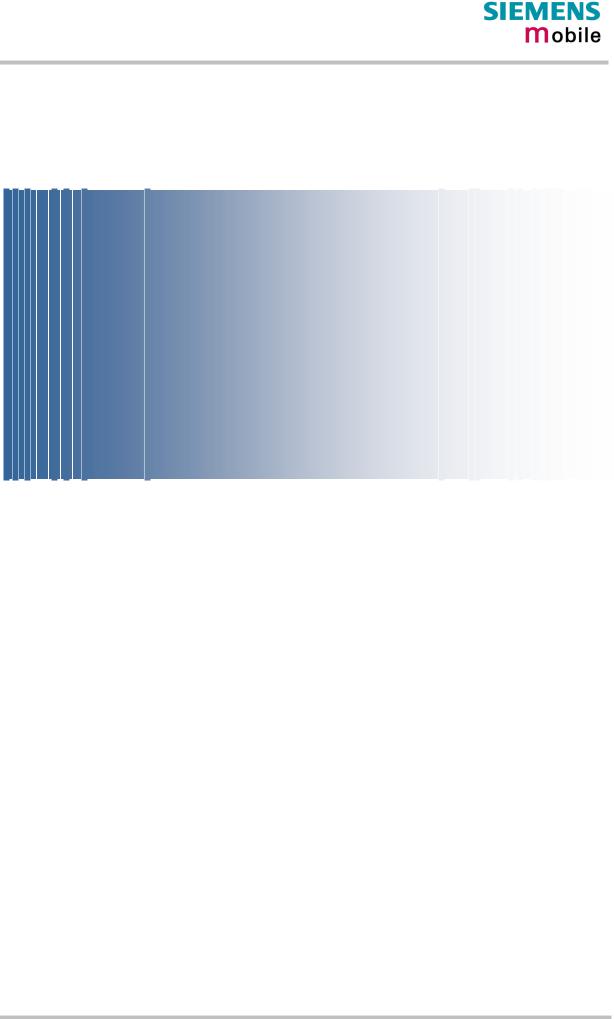
AT Command Set
Document Name: |
AT Command Set |
|
Siemens Cellular Engines |
Version: |
05.00 |
Date: |
July 15, 2002 |
Doc Id: |
MC35_ATC_01_V05.00 |
Status: |
Released |
General note
With respect to any damages arising in connection with the described product or this document, Siemens shall be liable according to the General Conditions on which the delivery of the described product and this document are based.
This product is not intended for use in life support appliances, devices or systems where a malfunction of the product can reasonably be expected to result in personal injury. Siemens AG customers using or selling this product for use in such applications do so at their own risk and agree to fully indemnify Siemens for any damages resulting from illegal use or resale.
Applications incorporating the described product must be designed to be in accordance with the technical specifications provided in these guidelines. Failure to comply with any of the required procedures can result in malfunctions or serious discrepancies in results.
Furthermore, all safety instructions regarding the use of mobile technical systems, including GSM products, which also apply to cellular phones must be followed.
Handheld applications such as mobile phones or PDAs incorporating the described product must be in accordance with the guidelines for human exposure to radio frequency energy. The Specific Absorption Rate (SAR) of the application must be evaluated and approved to be compliant with national and international safety standards or directives.
Subject to change without notice at any time.
Copyright
Copying of this document and giving it to others and the use or communication of the contents thereof, are forbidden without express authority. Offenders are liable to the payment of damages. All rights reserved in the event of grant of a patent or the registration of a utility model or design.
Copyright © Siemens AG 2002
MC35_ATC_01_V05.00 |
Page 2 of 256 |
15.07.2002 |

AT Command Set
Contents |
|
|
|
||
0 |
Version History ............................................................................................. |
9 |
|||
1 |
Introduction................................................................................................. |
13 |
|||
1.1 |
Scope of the document ........................................................................................................... |
13 |
|||
1.2 |
Supported product versions and related documents .............................................................. |
14 |
|||
1.3 |
Conventions ............................................................................................................................ |
15 |
|||
1.4 |
AT command syntax ............................................................................................................... |
15 |
|||
1.4.1 |
Using parameters.................................................................................................................... |
15 |
|||
1.4.2 |
Combining AT commands on the same command line .......................................................... |
16 |
|||
1.4.3 |
Entering successive AT commands on separate lines ........................................................... |
16 |
|||
1.5 |
Supported character sets ........................................................................................................ |
17 |
|||
1.6 |
Flow control |
............................................................................................................................. |
18 |
||
1.6.1 |
Software flow control (XON/OFF flow control) ........................................................................ |
18 |
|||
1.6.2 |
Hardware flow control (RTS/CTS flow control) ....................................................................... |
18 |
|||
2 |
Standard V.25ter AT Commands ............................................................... |
19 |
|||
2.1 |
A/ Repeat previous command line ......................................................................................... |
19 |
|||
2.2 |
+++ Switch from data mode or PPP online mode to command mode................................... |
19 |
|||
2.3 |
AT\Qn |
Flow control ................................................................................................................ |
20 |
||
2.4 |
ATA Answer a call.................................................................................................................. |
20 |
|||
2.5 |
ATD |
Mobile originated call to dial a number .......................................................................... |
21 |
||
2.6 |
ATD><mem><n> Originate call to phone number <n> in memory <mem> .......................... |
23 |
|||
2.7 |
ATD><n> Originate call to phone number selected from active memory.............................. |
25 |
|||
2.8 |
ATD><str> |
Originate call to phone number in memory with corresponding field .................. |
26 |
||
2.9 |
ATDI |
Mobile originated call to dialable ISDN number <n> .................................................... |
27 |
||
2.10 |
ATDL Redial last telephone number used ............................................................................. |
28 |
|||
2.11 |
ATE Enable command echo .................................................................................................. |
29 |
|||
2.12 |
ATH |
Disconnect existing connection ..................................................................................... |
29 |
||
2.13 |
ATI Display product identification information........................................................................ |
30 |
|||
2.14 |
ATI[value] Display additional identification information.......................................................... |
30 |
|||
2.15 |
ATL Set monitor speaker loudness........................................................................................ |
31 |
|||
2.16 |
ATM Set monitor speaker mode ............................................................................................ |
31 |
|||
2.17 |
ATO Switch from command mode to data mode / PPP online mode.................................... |
31 |
|||
2.18 |
ATQ |
Set result code presentation mode................................................................................ |
32 |
||
2.19 |
ATP |
Select pulse dialling ....................................................................................................... |
32 |
||
2.20 |
ATS0 |
|
Set number of rings before automatically answering the call ...................................... |
32 |
|
2.21 |
ATS3 Write command line termination character .................................................................. |
33 |
|||
2.22 |
ATS4 |
|
Set response formatting character............................................................................... |
33 |
|
2.23 |
ATS5 Write command line editing character.......................................................................... |
33 |
|||
2.24 |
ATS6 |
|
Set pause before blind dialling..................................................................................... |
34 |
|
2.25 |
ATS7 |
|
Set number of seconds to wait for connection completion .......................................... |
34 |
|
2.26 |
ATS8 Set number of seconds to wait for comma dial modifier.............................................. |
34 |
|||
2.27 |
ATS10 |
Set disconnect delay after indicating the absence of data carrier ............................. |
35 |
||
2.28 |
ATS18 |
Extended error report................................................................................................. |
35 |
||
2.29 |
ATT Select tone dialling ......................................................................................................... |
35 |
|||
2.30 |
ATV Set result code format mode.......................................................................................... |
36 |
|||
2.31 |
ATX Set CONNECT result code format and call monitoring.................................................. |
36 |
|||
2.32 |
ATZ Set all current parameters to user defined profile .......................................................... |
37 |
|||
2.33 |
AT&C |
Set circuit Data Carrier Detect (DCD) function mode.................................................. |
37 |
||
MC35_ATC_01_V05.00 |
Page 3 of 256 |
15.07.2002 |
|||
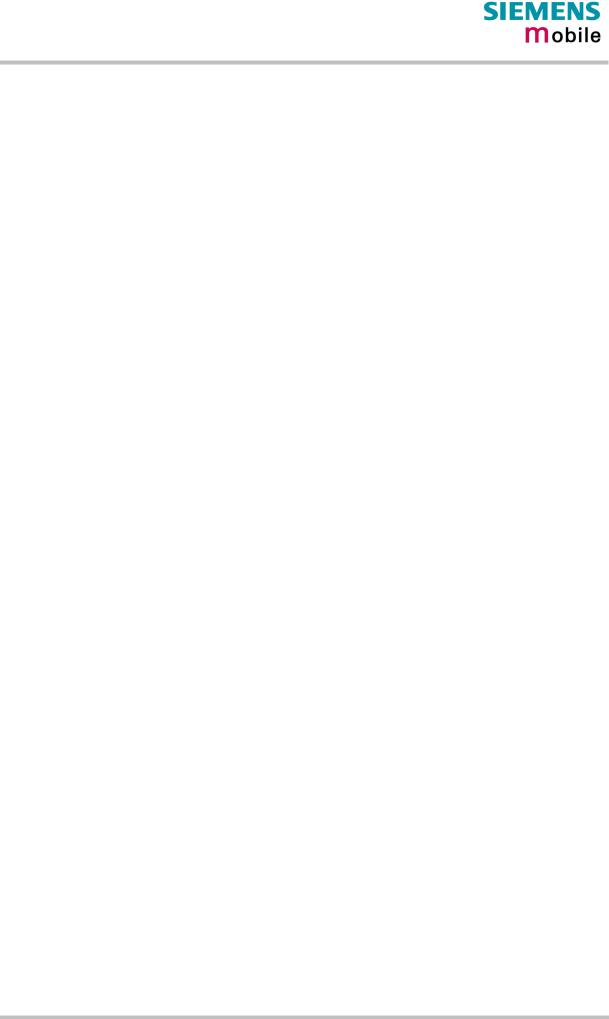
AT Command Set
2.34 |
AT&D Set circuit Data Terminal Ready (DTR) function mode............................................... |
38 |
|||
2.35 |
AT&F Set all current parameters to manufacturer defaults ................................................... |
39 |
|||
2.36 |
AT&S |
Set circuit Data Set Ready (DSR) function mode........................................................ |
41 |
||
2.37 |
AT&V |
Display current configuration ....................................................................................... |
42 |
||
2.38 |
AT&W |
Store current configuration to user defined profile ..................................................... |
43 |
||
2.39 |
AT+GCAP |
Request complete TA capabilities list .................................................................. |
44 |
||
2.40 |
AT+GMI Request manufacturer identification........................................................................ |
44 |
|||
2.41 |
AT+GMM Request TA model identification............................................................................ |
44 |
|||
2.42 |
AT+GMR |
Request TA revision identification of software status ............................................ |
45 |
||
2.43 |
AT+GSN Request TA serial number identification(IMEI)....................................................... |
45 |
|||
2.44 |
AT+ILRR Set TE-TA local rate reporting ................................................................................ |
46 |
|||
2.45 |
AT+IPR Set fixed local rate..................................................................................................... |
47 |
|||
2.45.1 |
Autobauding |
............................................................................................................................ |
48 |
||
3 |
AT Commands for FAX............................................................................... |
49 |
|||
3.1 |
AT+FBADLIN Bad Line Treshold........................................................................................... |
49 |
|||
3.2 |
AT+FBADMUL Error Threshold Multiplier.............................................................................. |
50 |
|||
3.3 |
AT+FBOR Query data bit order ............................................................................................. |
50 |
|||
3.4 |
AT+FCIG |
Query or set the Local polling id ............................................................................ |
51 |
||
3.5 |
AT+FCLASS |
Fax: Select, read or test service class ............................................................. |
51 |
||
3.6 |
AT+FCQ Copy Quality Checking ........................................................................................... |
52 |
|||
3.7 |
AT+FCR Capability to receive................................................................................................ |
52 |
|||
3.8 |
AT+FDCC Query or set capabilities....................................................................................... |
53 |
|||
3.9 |
AT+FDFFC Data Compression Format Conversion.............................................................. |
54 |
|||
3.10 |
AT+FDIS Query or set session parameters........................................................................... |
55 |
|||
3.11 |
AT+FDR Begin or continue phase C data reception.............................................................. |
56 |
|||
3.12 |
AT+FDT Data Transmission .................................................................................................. |
56 |
|||
3.13 |
AT+FET End a page or document ......................................................................................... |
57 |
|||
3.14 |
AT+FK |
Kill operation, orderly FAX abort................................................................................ |
57 |
||
3.15 |
AT+FLID Query or set the Local Id setting capabilities ......................................................... |
57 |
|||
3.16 |
AT+FMDL Identify Product Model.......................................................................................... |
58 |
|||
3.17 |
AT+FMFR |
Request Manufacturer Identification .................................................................... |
58 |
||
3.18 |
AT+FOPT |
Set bit order independently................................................................................... |
58 |
||
3.19 |
AT+FPHCTO DTE Phase C Response Timeout ................................................................... |
59 |
|||
3.20 |
AT+FREV |
Identify Product Revision...................................................................................... |
59 |
||
3.21 |
AT+FRH Receive Data Using HDLC Framing ....................................................................... |
59 |
|||
3.22 |
AT+FRM Receive Data .......................................................................................................... |
60 |
|||
3.23 |
AT+FRS Receive Silence ...................................................................................................... |
60 |
|||
3.24 |
AT+FTH Transmit Data Using HDLC Framing ...................................................................... |
60 |
|||
3.25 |
AT+FTM Transmit Data ......................................................................................................... |
61 |
|||
3.26 |
AT+FTS Stop Transmission and Wait ................................................................................... |
61 |
|||
3.27 |
AT+FVRFC |
Vertical resolution format conversion ................................................................. |
62 |
||
4 |
AT Commands originating from GSM 07.07 ............................................. |
63 |
|||
4.1 |
AT+CACM Accumulated call meter (ACM) reset or query .................................................... |
63 |
|||
4.2 |
AT+CALA Set alarm time....................................................................................................... |
64 |
|||
4.3 |
AT+CAMM Accumulated call meter maximum (ACMmax) set or query................................ |
67 |
|||
4.4 |
AT+CAOC Advice of Charge information .............................................................................. |
68 |
|||
4.5 |
AT+CBST |
Select bearer service type .................................................................................... |
69 |
||
4.6 |
AT+CCFC Call forwarding number and conditions control.................................................... |
70 |
|||
4.6.1 |
Examples: Call forwarding ...................................................................................................... |
71 |
|||
4.7 |
AT+CCLK Real Time Clock ................................................................................................... |
73 |
|||
4.8 |
AT+CCUG: Closed User Group .............................................................................................. |
74 |
|||
4.9 |
AT+CCWA Call waiting .......................................................................................................... |
75 |
|||
4.10 |
AT+CEER Extended error report ........................................................................................... |
77 |
|||
MC35_ATC_01_V05.00 |
Page 4 of 256 |
15.07.2002 |
|||
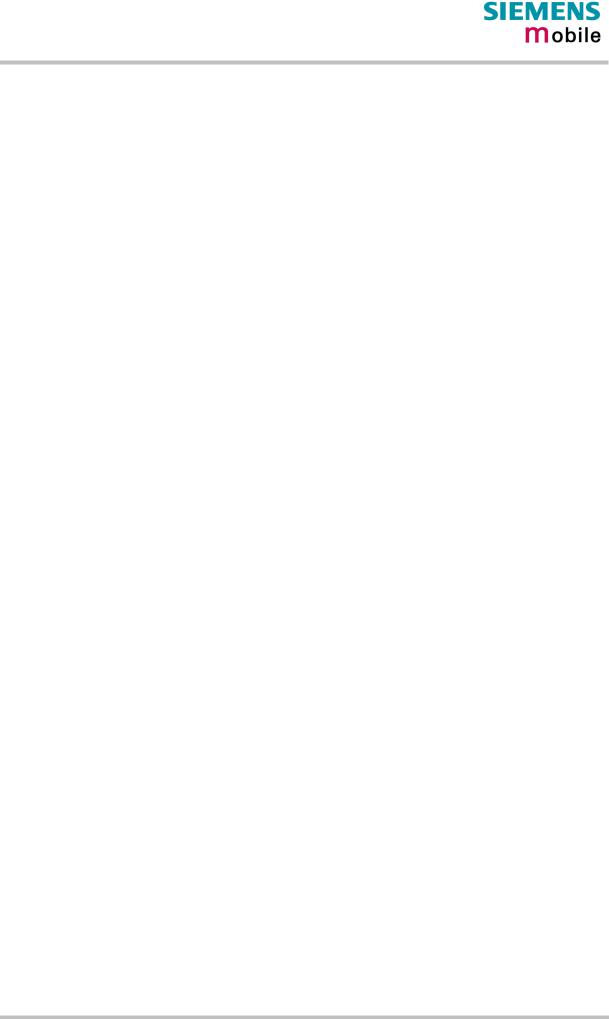
AT Command Set
4.11 |
AT+CFUN |
Set phone functionality......................................................................................... |
|
78 |
|
4.11.1 |
Wake up the ME from SLEEP mode....................................................................................... |
81 |
|||
4.12 |
AT+CGMI Request manufacturer identification ...................................................................... |
82 |
|||
4.13 |
AT+CGMM Request model identification............................................................................... |
82 |
|||
4.14 |
AT+CGMR |
Request revision identification of software status ............................................... |
82 |
||
4.15 |
AT+CGSN |
Request product serial number identification (IMEI) identical to GSN ................ |
83 |
||
4.16 |
AT+CHLD Call hold and multiparty......................................................................................... |
|
83 |
||
4.17 |
AT+CHUP Hang up call ......................................................................................................... |
|
84 |
||
4.18 |
AT+CIMI Request international mobile subscriber identity.................................................... |
84 |
|||
4.19 |
AT+CIND Indicator control ...................................................................................................... |
|
85 |
||
4.20 |
AT+CLCC |
|
List current calls of ME ......................................................................................... |
|
87 |
4.21 |
AT+CLCK |
|
Facility lock ........................................................................................................... |
|
88 |
4.21.1 |
Examples: Enabling / disabling PIN 1 authentication ............................................................. |
90 |
|||
4.21.2 |
Examples: Phone lock............................................................................................................. |
|
91 |
||
4.21.3 |
Examples: Call barring ............................................................................................................ |
|
93 |
||
4.22 |
AT+CLIP |
Calling line identification presentation.................................................................... |
94 |
||
4.23 |
AT+CLIR |
Calling line identification restriction (by *# sequence) ........................................... |
95 |
||
4.24 |
AT+CLVL Loudspeaker volume level .................................................................................... |
96 |
|||
4.25 |
AT+CMEE Report mobile equipment error ............................................................................ |
97 |
|||
4.26 |
AT+CMER Mobile equipment event reporting ....................................................................... |
98 |
|||
4.27 |
AT+CMUT Mute control ....................................................................................................... |
|
100 |
||
4.28 |
AT+CMUX Enter multiplex mode......................................................................................... |
|
101 |
||
4.28.1 |
Restricted use of AT commands in Multiplex mode.............................................................. |
102 |
|||
4.29 |
AT+COPN Read operator names ........................................................................................ |
|
104 |
||
4.30 |
AT+COPS Operator selection.............................................................................................. |
|
105 |
||
4.31 |
AT+CPAS |
|
Mobile equipment activity status ........................................................................ |
107 |
|
4.32 |
AT+CPBR Read current phonebook entries........................................................................ |
108 |
|||
4.33 |
AT+CPBS Select phonebook memory storage.................................................................... |
109 |
|||
4.34 |
AT+CPBW Write phonebook entry |
...................................................................................... |
110 |
||
4.35 |
AT+CPIN Enter PIN ............................................................................................................. |
|
111 |
||
4.35.1 |
What to do if PIN or password authentication fails? ............................................................. |
114 |
|||
4.36 |
AT+CPIN2 Enter PIN2 ......................................................................................................... |
|
116 |
||
4.37 |
AT+CPUC Price per unit and currency table ....................................................................... |
118 |
|||
4.38 |
AT+CPWD Change password ............................................................................................. |
|
119 |
||
4.39 |
AT+CR Service reporting control ......................................................................................... |
|
122 |
||
4.40 |
AT+CRC |
Set Cellular Result Codes for incoming call indication......................................... |
123 |
||
4.41 |
AT+CREG Network registration........................................................................................... |
|
124 |
||
4.42 |
AT+CRLP |
|
Select radio link protocol param. for orig. non-transparent data call.................. |
126 |
|
4.43 |
AT+CRSM Restricted SIM access....................................................................................... |
|
127 |
||
4.44 |
AT+CSCS Set TE character set........................................................................................... |
|
128 |
||
4.45 |
AT+CSNS Single Numbering Scheme ................................................................................ |
129 |
|||
4.46 |
AT+CSQ |
Signal quality ........................................................................................................ |
|
130 |
|
4.47 |
AT+CSSN |
Supplementary service notifications................................................................... |
131 |
||
4.48 |
AT+CUSD Unstructured supplementary service data ......................................................... |
132 |
|||
4.49 |
AT+VTD=<n> Tone duration................................................................................................ |
|
133 |
||
4.50 |
AT+VTS DTMF and tone generation (<Tone> in {0-9, *, #, A, B, C, D}) ............................. |
133 |
|||
4.51 |
AT+WS46 Select wireless network ....................................................................................... |
|
134 |
||
5 |
AT commands originating from GSM 07.05 for SMS ............................. |
135 |
|||
5.1 |
AT+CMGC Send an SMS command ................................................................................... |
135 |
|||
5.2 |
AT+CMGD Delete SMS message........................................................................................ |
|
136 |
||
5.3 |
AT+CMGF Select SMS message format ............................................................................. |
136 |
|||
5.4 |
AT+CMGL List SMS messages from preferred store .......................................................... |
137 |
|||
5.5 |
AT+CMGR Read SMS message ......................................................................................... |
|
140 |
||
5.6 |
AT+CMGS Send SMS message.......................................................................................... |
|
143 |
||
5.7 |
AT+CMGW Write SMS message to memory....................................................................... |
145 |
|||
5.8 |
AT+CMSS Send SMS message from storage..................................................................... |
147 |
|||
MC35_ATC_01_V05.00 |
Page 5 of 256 |
15.07.2002 |
|||

AT Command Set
5.9 |
AT+CNMA New SMS message acknowledge to ME/TE, only phase 2+ ............................ |
|
148 |
||
5.10 |
AT+CNMI New SMS message indications .......................................................................... |
|
149 |
||
5.11 |
AT+CPMS Preferred SMS message storage ...................................................................... |
|
152 |
||
5.12 |
AT+CSCA SMS service centre address .............................................................................. |
|
154 |
||
5.13 |
AT+CSCB Select cell broadcast messages......................................................................... |
|
155 |
||
5.14 |
AT+CSDH Show SMS text mode parameters ..................................................................... |
|
156 |
||
5.15 |
AT+CSMP Set SMS text mode parameters......................................................................... |
|
157 |
||
5.16 |
AT+CSMS Select Message Service .................................................................................... |
|
158 |
||
6 |
GPRS AT commands in accordance with GSM 07.07............................ |
|
159 |
||
6.1 |
Commands specific to MTs supporting GPRS ..................................................................... |
|
159 |
||
6.1.1 |
AT+CGATT GPRS attach and detach ................................................................................. |
|
159 |
||
6.1.2 |
AT+CGACT PDP context activate or deactivate.................................................................. |
|
160 |
||
6.1.3 |
AT+CGDATA Enter data state ............................................................................................. |
|
161 |
||
6.1.4 |
AT+CGDCONT Define PDP Context................................................................................... |
|
162 |
||
6.1.5 |
AT+CGQMIN |
Quality of Service Profile (Minimum acceptable) .......................................... |
|
164 |
|
6.1.6 |
AT+CGQREQ |
Quality of Service Profile (Requested)......................................................... |
|
168 |
|
6.1.7 |
AT+CGSMS Select service for MO SMS messages ........................................................... |
|
172 |
||
6.1.8 |
AT^SGAUTH |
Set type of authentication for PPP connection ............................................. |
|
173 |
|
6.2 |
Modem compatibility commands to MTs supporting GPRS ................................................. |
|
174 |
||
6.3 |
ATD *99# Request GPRS service ....................................................................................... |
|
174 |
||
6.3.1 |
ATD *98# Request GPRS IP service .................................................................................. |
|
175 |
||
6.3.2 |
ATH Manual rejection of a network request for PDP context activation .............................. |
|
176 |
||
6.4 |
Using GPRS AT commands (examples)............................................................................... |
|
177 |
||
6.4.1 |
Miscellaneous AT commands ............................................................................................... |
|
177 |
||
6.5 |
Using the GPRS dial command ATD .................................................................................... |
|
179 |
||
7 |
AT Commands for SIM Application Toolkit (GSM 11.14)....................... |
|
180 |
||
7.1 |
AT^SSTA Remote-SAT Interface Activation......................................................................... |
|
181 |
||
7.2 |
^SSTN Remote-SAT Notification .......................................................................................... |
|
182 |
||
7.3 |
AT^SSTGI Remote-SAT Get Information ............................................................................. |
|
183 |
||
7.4 |
AT^SSTR Remote-SAT Response ....................................................................................... |
|
184 |
||
8 |
Siemens defined AT commands for enhanced functions ..................... |
|
185 |
||
8.1 |
AT+CXXCID Display card ID (identical to AT^SCID)........................................................... |
|
185 |
||
8.2 |
AT^MONI Monitor idle mode and dedicated mode.............................................................. |
|
186 |
||
8.3 |
AT^MONP Monitor neighbour cells...................................................................................... |
|
188 |
||
8.4 |
AT^SACM Advice of charge and query of ACM and ACMmax ........................................... |
|
189 |
||
8.5 |
AT^SBC Battery charging / discharging and charge control................................................ |
|
190 |
||
8.6 |
AT^SCID |
Display SIM card identification number................................................................ |
|
193 |
|
8.7 |
AT^SCKS Set SIM connection presentation mode and query SIM connection status ........ |
194 |
|||
8.8 |
AT^SCNI |
List Call Number Information ............................................................................... |
|
195 |
|
8.9 |
AT^SCTM |
Set critical operating temperature presentation mode or query temperature..... |
196 |
||
8.10 |
AT^SDLD Delete the “last number redial“ memory.............................................................. |
|
198 |
||
8.11 |
AT^SHOM Display Homezone............................................................................................. |
|
198 |
||
8.12 |
AT^SLCD Display Last Call Duration................................................................................... |
|
198 |
||
8.13 |
AT^SLCK |
Facility lock.......................................................................................................... |
|
199 |
|
8.14 |
AT^SMGL List SMS messages from preferred storage....................................................... |
|
201 |
||
8.15 |
AT^SMGO Set or query SMS overflow presentation mode or query SMS overflow ........... |
|
202 |
||
8.16 |
AT^SMSO |
Switch off mobile station .................................................................................... |
|
203 |
|
8.17 |
AT^SMGR Read SMS message without set to REC READ................................................ |
|
203 |
||
8.18 |
AT^SM20 Set M20 Compatibility ......................................................................................... |
|
204 |
||
8.19 |
AT^SNFA Set or query microphone attenuation.................................................................. |
|
205 |
||
MC35_ATC_01_V05.00 |
Page 6 of 256 |
15.07.2002 |
|||
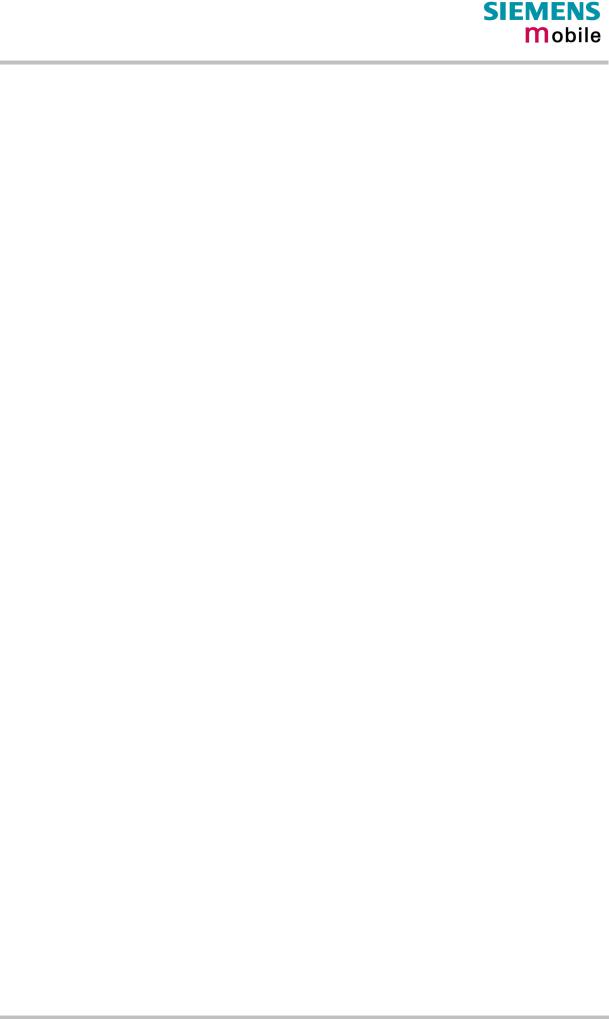
AT Command Set
8.20 |
AT^SNFD |
Set audio parameters to manufacturer default values........................................ |
206 |
8.21 |
AT^SNFI Set microphone path parameters ......................................................................... |
207 |
|
8.22 |
AT^SNFM Mute microphone................................................................................................ |
208 |
|
8.23 |
Audio programming model.................................................................................................... |
208 |
|
8.24 |
AT^SNFO |
Set audio output (= loudspeaker path) parameter.............................................. |
209 |
8.25 |
AT^SNFPT |
Call progress tones .......................................................................................... |
210 |
8.26 |
AT^SNFS Select audio hardware set................................................................................... |
211 |
|
8.27 |
AT^SNFV Set loudspeaker volume...................................................................................... |
212 |
|
8.28 |
AT^SNFW |
Write audio setting in non-volatile store ............................................................. |
212 |
8.29 |
AT^SPBC |
Search the first entry in the sorted telephone book ............................................ |
213 |
8.30 |
AT^SPBG |
Read entry from active telephone book via sorted index ................................... |
214 |
8.31 |
AT^SPBS Steps the selected phonebook alphabetically..................................................... |
215 |
|
8.32 |
AT^SPIC Display PIN counter.............................................................................................. |
216 |
|
8.33 |
AT^SPLM Read the PLMN list ............................................................................................. |
217 |
|
8.34 |
AT^SPLR Read entry from the preferred operators list ....................................................... |
218 |
|
8.35 |
AT^SPLW |
Write an entry to the preferred operators list...................................................... |
219 |
8.36 |
AT^SPWD Change password for a lock .............................................................................. |
220 |
|
8.37 |
AT^SRTC |
Select, query, test ring tone parameters............................................................. |
222 |
8.38 |
AT^SSCONF SMS Configuration........................................................................................ |
224 |
|
8.39 |
AT^SSDA |
Set Display Availability....................................................................................... |
225 |
8.40 |
AT^SSYNC Configure SYNC Pin......................................................................................... |
226 |
|
8.41 |
AT^STCD Display Total Call Duration ................................................................................. |
228 |
|
9 |
APPENDIX ................................................................................................. |
229 |
|
9.1 |
Summary of ERRORS and Messages.................................................................................. |
229 |
|
9.1.1 |
Summary of CME ERRORS related to GSM 07.07.............................................................. |
229 |
|
9.1.2 |
Summary of GPRS-related CME ERRORS.......................................................................... |
230 |
|
9.1.3 |
Summary of CMS ERRORS related to GSM 07.05.............................................................. |
231 |
|
9.1.4 |
Summary of Unsolicited Result Codes (URC) ...................................................................... |
234 |
|
9.1.5 |
Result codes ......................................................................................................................... |
237 |
|
9.1.6 |
Cause Location ID for the extended error report (AT+CEER) .............................................. |
237 |
|
9.1.7 |
GSM release cause for L3 Radio Resource (RR) (AT+CEER) ........................................... |
238 |
|
9.1.8 |
SIEMENS release cause for L3 Radio Resource (RR) (AT+CEER) ................................... |
238 |
|
9.1.9 |
GSM release cause for Mobility Management (MM) (AT+CEER) ........................................ |
239 |
|
9.1.10 |
SIEMENS release cause for L3 Mobility Management (MM) (AT+CEER) ........................... |
240 |
|
9.1.11 |
GSM release cause for L3 Call Control (CC) (AT+CEER) ................................................... |
240 |
|
9.1.12 |
SIEMENS release cause for L3 Call Control (CC) (AT+CEER) ........................................... |
241 |
|
9.1.13 |
SIEMENS release cause for L3 Advice of Charge (AOC) (AT+CEER) ............................... |
242 |
|
9.1.14 |
GSM release cause for Supplementary Service call (AT+CEER) ........................................ |
242 |
|
9.1.15 |
Siemens release cause for Call related Supplementary Services (CRSS) (AT+CEER) .... |
243 |
|
9.1.16 |
GSM release cause for Session Management (SM) (AT+CEER) ........................................ |
243 |
|
9.1.17 |
SIEMENS release cause for Session Management (SM) (AT+CEER) ................................ |
244 |
|
9.1.18 |
SIEMENS release cause for GPRS API (AT+CEER) .......................................................... |
244 |
|
9.1.19 |
SIEMENS release cause for Embedded Netcore (AT+CEER)........................................... |
245 |
|
9.2 |
Summary of PIN requiring AT Commands............................................................................ |
246 |
|
9.3 |
AT commands available before entering the SIM PIN.......................................................... |
248 |
|
9.4 |
Standard GSM service codes ............................................................................................... |
250 |
|
9.4.1 |
Additional notes on ^SCCFC, ^SCCWA, ^SCLCK ............................................................... |
252 |
|
9.5 |
GSM and UCS2 alphabet tables........................................................................................... |
254 |
|
MC35_ATC_01_V05.00 |
Page 7 of 256 |
15.07.2002 |
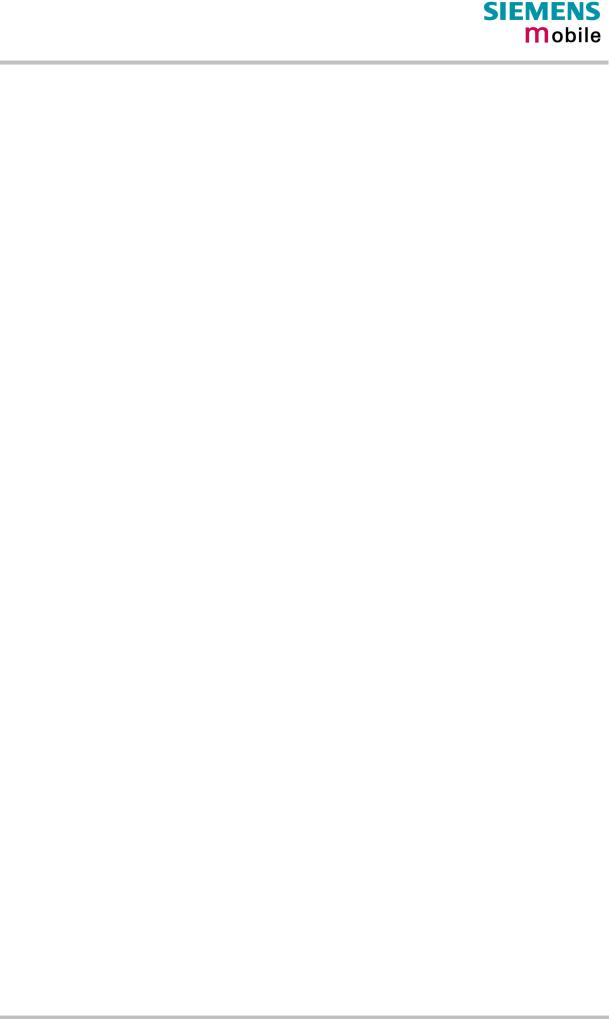
AT Command Set
Figures |
|
Figure 1: AT audio programming model............................................................................................... |
208 |
Tables |
|
Table 1: Product specific use of AT commands..................................................................................... |
13 |
Table 2: Types of AT commands and responses................................................................................... |
15 |
Table 3: Illegal combinations of AT commands ..................................................................................... |
16 |
Table 4: Character definitions depending on alphabet (examples)........................................................ |
17 |
Table 5: Factory settings ........................................................................................................................ |
39 |
Table 6: Summary of AT commands available in Alarm mode .............................................................. |
66 |
Table 7: Wake-up events in NON-CYCLIC and CYCLIC SLEEP mode ................................................ |
81 |
Table 8: Availability of AT commands on virtual channels ................................................................... |
102 |
Table 9: Summary of AT commands with different behaviour in Multiplex mode ............................... |
103 |
Table 10: Timing algorithm of incorrect password input....................................................................... |
114 |
Table 11: Summary of AT commands available in Charge-only and Alarm mode .............................. |
192 |
Table 12: Operating modes of the ME indicated by status LED (if <mode> = 1):................................ |
227 |
Table 13: Summary of URCs................................................................................................................ |
234 |
Table 14: Summary of Fax Class 2 URCs defined by EIA PN-2388 ................................................... |
236 |
Table 15: GSM service codes .............................................................................................................. |
250 |
MC35_ATC_01_V05.00 |
Page 8 of 256 |
15.07.2002 |

AT Command Set
0 Version History
This chapter reports modifications and improvements over previous versions of the document.
"AT Command Set" Version MC35-ATC_01_V04.00 => MC35-ATC_01_V05.00
|
Chapter |
Page |
AT command |
|
What is new |
|
|
|
|
|
|
|
|
|
|
|
1.5 |
17 |
Character sets |
|
Chapter revised and associated character set tables |
|
|
|
|
|
|
|
in Chapter 9.5 updated. |
|
|
|
1.6 |
18 |
Flow control |
|
How to use flow control. |
|
|
|
2.3 |
20 |
AT\Q<n> |
|
Further details added: Using RTS/CTS handshake. |
|
|
|
|
|
|
|
Restoring AT\Q settings. |
|
|
|
2.12 |
29 |
ATH |
|
Notes on Multiplex mode and GPRS operation cor- |
|
|
|
|
|
|
|
rected |
|
|
|
2.35 |
39 |
AT&F |
|
Added further commands to list of factory settings |
|
|
|
2.45 |
47 |
AT+IPR |
|
Added note on minimum bit rate. |
|
|
|
4.6 |
70 |
AT+CCFC |
|
Added note on applicability of <class> according to |
|
|
|
|
|
|
|
GSM02.04. |
|
|
|
4.9 |
75 |
AT+CCWA |
|
AT+CHLD can be used to put an active call on hold an |
|
|
|
|
|
|
|
accept a waiting voice call. Not for data or fax calls. |
|
|
|
|
|
|
|
Added notes on applicability of different <class>es. |
|
|
|
4.11 |
78 |
AT+CFUN |
|
Chapter revised. |
|
|
|
4.16 |
83 |
AT+CHLD |
|
Removed note on GPRS. |
|
|
|
|
|
|
|
Added notes: AT+CHLD for voice calls only. Further |
|
|
|
|
|
|
|
information on Call Waiting. |
|
|
|
4.19 |
85 |
AT+CIND |
|
Revised Chapter. |
|
|
|
4.21 |
88 |
AT+CLCK |
|
Corrected description of “FD” lock: PIN2 is requested |
|
|
|
8.13 |
199 |
AT^SLCK |
|
as password (it is not sufficient to have done PIN2 au- |
|
|
|
|
|
|
|
thentication before). |
|
|
|
|
|
|
|
Added notes on applicability of different <class>es |
|
|
|
|
|
|
|
and <fac>s. |
|
|
|
4.21.2 |
91 |
AT+CLCK |
|
Modified examples. |
|
|
|
4.24 |
96 |
AT+CLVL |
|
Added information on related AT commands |
|
|
|
|
|
|
|
AT^SNF0, AT^SNFV, AT^SNFS |
|
|
|
4.26 |
98 |
AT+CMER |
|
Revised Chapter. |
|
|
|
4.27 |
100 |
AT+CMUT |
|
Added information on related AT commands |
|
|
|
|
|
|
|
AT^SNF0, AT^SNFM, AT^SNFS |
|
|
|
4.28.1 |
102f |
AT+CMUX |
|
AT\Q3 (hardware flow control) is recommended. |
|
|
|
|
|
|
|
Notes regarding execution of ATH on different chan- |
|
|
|
|
|
|
|
nels corrected. |
|
|
|
4.36 |
116 |
AT+CPIN2 |
|
Added more details on validity of CPIN2 authentica- |
|
|
|
|
|
|
|
tion. |
|
|
|
4.44 |
128 |
AT+CSCS |
|
Further details added: Using RTS/CTS handshake. |
|
|
|
|
|
|
|
Restoring AT\Q settings. |
|
|
|
4.49 |
133 |
AT+VTD |
|
Revised chapters. |
|
|
|
4.50 |
133 |
AT+VTS |
|
|
|
|
|
|
|
|
|
|
|
|
|
5.4 |
137 |
AT+CMGL |
|
Removed all information on CB messages. |
|
|
|
5.5 |
140 |
AT+CMGR |
|
Added note regarding AT^SSCONF. |
|
|
|
5.7 |
145 |
AT+CMGW |
|
Parameter <length> corrected (only required for PDU, |
|
|
|
|
|
|
|
not for text mode). |
|
|
|
|
|
|
|
Result code after failure of storing a message to the |
|
|
|
|
|
|
|
|
|
|
MC35_ATC_01_V05.00 |
|
Page 9 of 256 |
15.07.2002 |
||||
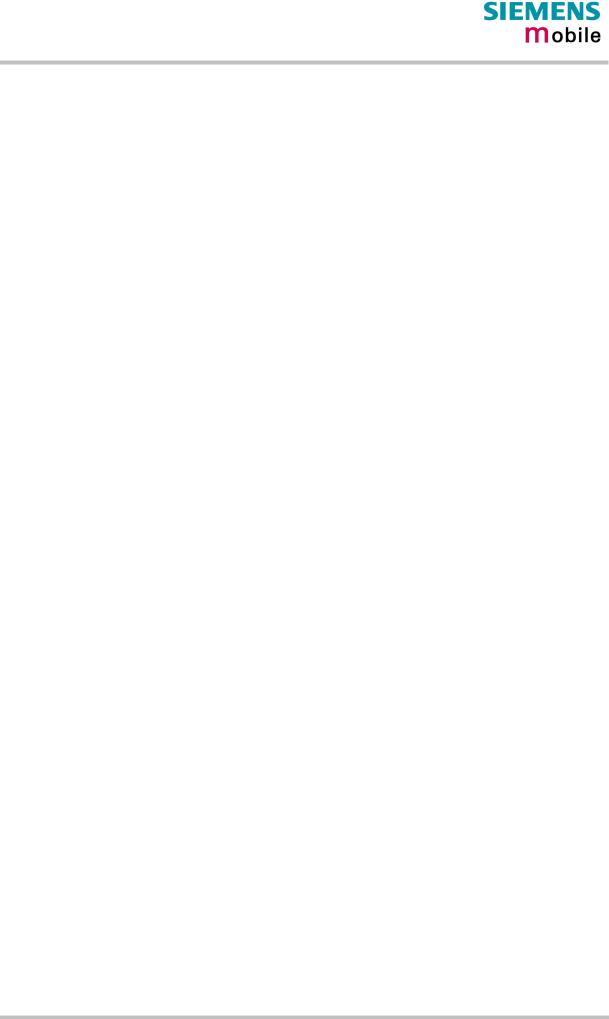
AT Command Set
|
|
|
SIM card (ME returns OK or ERROR depending on |
|
|
|
setting of AT^SM20). |
|
|
|
Statement about sending e-mails via SMS corrected: |
|
|
|
If not recognized by provider, @ may be replaced with |
|
|
|
“*”. |
5.10 |
149 |
AT+CNMI |
Notes regarding AT^SSCONF and AT^SMGO added. |
|
|
|
Note regarding the handling of Class 0 short mes- |
|
|
|
sages added. |
5.11 |
152 |
AT+CPMS |
<mem3> now offers the choice between “MT” and |
|
|
|
“SM” |
|
|
|
<mem1>, <mem2> and <mem3> are now stored non- |
|
|
|
volatile. |
|
|
|
Added notes on handling <mem3>. |
6.1.7 |
172 |
AT+CGSMS |
Modified parameter <service>=2 (GPRS preferred): |
|
|
|
No SMS via GPRS during a circuit switched call. |
6.1.8 |
173 |
AT^SGAUTH |
Notes added: Parameter cannot be stored with |
|
|
|
AT&W. Default value after power-up is <auth>=3 |
|
|
|
(PAP and CHAP). |
6.3.2 |
176 |
ATH |
Notes on deactivation of PDP context and GPRS con- |
|
|
|
nection removed. |
8.2 |
186f |
AT^MONI |
Response example b): Parameter C1 corrected. |
|
|
|
<chann> and <rs> explained in greater detail |
|
|
|
References for 3GPP TS 05.05 and 05.08 added |
|
|
|
Notes modified: |
|
|
|
If the radio cell changes during a connection, the pa- |
|
|
|
rameters PWR and RXLev of the ‘Serving Cell’ part |
|
|
|
will not be updated, and updating the Cell ID takes 1 |
|
|
|
or 2 seconds. |
8.3 |
188 |
AT^MONP |
<chann> and <rs> explained in greater detail |
|
|
|
Notes modified: During a connection new neighbour |
|
|
|
cells can be added, but their parameters C1 and C2 |
|
|
|
will be updated after the call. |
8.15 |
202 |
AT^SMGO |
Added note: Indication of URC requires |
|
|
|
AT+CNMI=3,1. SMS indication during data transfer |
|
|
|
via Break (100ms) |
8.19 - 8.28 |
205 - 212 |
AT^SNF… |
All Chapters revised. |
8.25 |
210 |
AT^SNFPT |
New AT command: Call progress tones |
8.37 |
222 |
AT^SRTC |
New AT command: Select, query, test ringing tones |
8.38 |
224 |
AT^SSCONF |
New AT command: Configuring recipient address pa- |
|
|
|
rameters in SMS result codes and in +CDS URCs. |
9.1.3 |
231 |
CMS errors |
Note and example added: Mapping of CME and CMS |
|
|
|
errors if SIM PIN authentication has not been done. |
9.1.4 |
234 |
URCs |
Added: URCs will be output after command execution. |
|
|
|
Added list of Fax Class 2 URCs. |
9.1.5 |
237 |
Result codes |
Removed 3 result codes “CONNECT…”, and pre- |
|
|
|
served those wich include “CONNECT …/RLP” |
|
|
Added to List of PIN1 requiring AT commands: |
|
|
|
AT+CPIN2, AT^SSDA |
|
9.3 |
248f |
Added to List of PIN1 independent AT commands: |
|
|
|
AT+VTS, AT^SNFPT, AT^SRTC, AT^SSCONF |
|
MC35_ATC_01_V05.00 |
Page 10 of 256 |
15.07.2002 |

AT Command Set
"AT Command Set" Version MC35-ATC_01_V03.02 => MC35-ATC_01_V04.00
Chapter |
Page |
AT command |
What is new |
|
|
|
|
2.2 |
19 |
+++ |
Chapter revised. |
2.5 |
21 |
ATD |
Parameters “G” and “g” for Closed User Group added. |
2.17 |
31 |
ATO |
Chapter revised. |
4.8 |
74 |
AT+CCUG |
New AT command: Closed User Group. |
4.9 |
75 |
AT+CCWA |
New AT command: Call Waiting. |
4.19 |
85 |
AT+CIND |
New AT command: Indicator control. |
4.21 |
88 |
AT+CLCK |
Under parameter “PS” lock, the following statement |
|
|
|
has been removed: “ME may remember numbers of |
|
|
|
previously used cards.” |
4.26 |
98 |
AT+CMER |
New AT command: Mobile equipment event reporting. |
8.2 |
186f |
AT^MONI |
Statement regarding RING line revised. |
8.3 |
188 |
At^MONP |
|
8.19 |
205 |
AT^SNFA |
New AT command: Set or query microphone attenua- |
|
|
|
tion |
8.39 |
225 |
AT^SSDA |
New AT command: Set Display Availability |
9.1.4 |
234 |
+CIEV: <text> added to list of URCs |
|
9.2 - 9.3 |
246f - 248f |
AT+CCUG, |
Added to Chapter 9.2 (PIN 1 required). |
|
|
AT+CCWA, |
|
|
|
AT+CMER, |
|
|
|
AT^SSDA |
|
|
|
AT+CIND |
Added to Chapter 9.3 (PIN1 independent) |
|
|
AT^SNFA |
|
|
|
|
|
"AT Command Set" Version MC35-ATC_01_V02.00 => MC35_ATC_01_V03.02
|
Chapter |
Page |
AT command |
|
What is new |
|
|
|
|
|
|
|
|
|
|
|
1.4.2 |
16 |
Note regarding sequential order of concatenated commands added. |
|
|||
|
4.5 |
69 |
AT+CBST |
|
Command syntax corrected: Parameter <speed> is |
|
|
|
|
|
|
|
mandatory. |
|
|
|
4.6 |
70 |
AT+CCFC |
|
New <class> parameters added. |
|
|
|
4.11 |
78 |
AT+CFUN |
|
SLEEP mode described in greater detail |
|
|
|
4.21 |
88 |
AT+CLCK |
|
New <class> parameters added. |
|
|
|
4.35.1 |
114 |
AT+CPIN |
|
Timing algorithm of incorrect password corrected |
|
|
|
4.46 |
130 |
AT+CSQ |
|
Note added: Realistic BER values can be obtained |
|
|
|
|
|
|
|
only if there is a call in progress. |
|
|
|
5.11 |
152 |
AT+CPMS |
|
Difference between SM, ME and MT storage ex- |
|
|
|
|
|
|
|
plained. |
|
|
|
6.1.8 |
173 |
AT^SGAUTH |
|
New command to specify protocol for PPP authentica- |
|
|
|
|
|
|
|
tion |
|
|
|
8.2 |
186f |
AT^MONI |
|
Channel numbers are now issued in the form of 4-digit |
|
|
|
|
|
|
|
numbers. Therefore, the examples on page 186 have |
|
|
|
|
|
|
|
been updated. |
|
|
|
|
|
|
|
Frequency hopping will now be indicated with “h” (in- |
|
|
|
|
|
|
|
stead of the previously used “0”. |
|
|
|
|
|
|
|
|
|
|
MC35_ATC_01_V05.00 |
|
Page 11 of 256 |
15.07.2002 |
||||

AT Command Set
|
|
|
Notes modified: If during a connection the radio cell is |
|
|
|
changed, the parameters LAC, Cell, NCC BCC, PWR |
|
|
|
and RXLev of the ‘Serving Cell’ part will not be up- |
|
|
|
dated. |
8.7 |
194 |
AT^SCKS |
Notes regarding empty SIM card tray modified. |
8.9 |
196 |
AT^SCTM |
Chapter revised due to improved presentation of tem- |
|
|
|
perature shutdown URCs. |
9.2 - 9.3 246f - 248f AT+CXXCID
AT^SCID
AT^SGAUTH
Both commands now independent of PIN authentication
Command added to list of PIN independent commands
9.1 - 9.1.19 |
229 - 245f |
Lists of result codes restructured. |
|
9.1.12 |
241 |
Notification number 300 added: “Called party barred incoming call” |
|
|
|
|
|
9.4 |
250f |
*# codes |
Chapter revised. Further examples added. |
9.4.1252f
MC35_ATC_01_V05.00 |
Page 12 of 256 |
15.07.2002 |
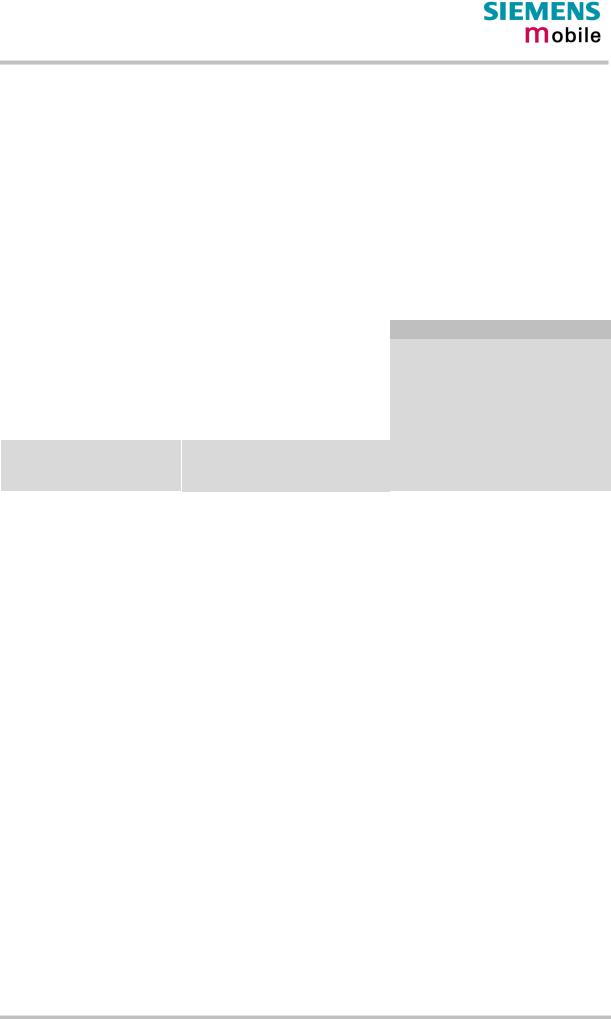
AT Command Set
1 Introduction
1.1Scope of the document
This document presents the AT Command Set for the Siemens cellular engines
MC35 Module
MC35 Terminal
The AT commands detailed in this document are supported by both products. Where differences occur, they are noted in the chapter that refers to the command. In the present version, the only exceptions concern these commands:
Table 1: Product specific use of AT commands
AT command |
MC35 Module |
AT+CALA, Chapter 4.2 |
Alarm mode and reminder call |
|
fully applicable |
|
|
AT^SSYNC, Chapter 8.40 SYNC pin may be assigned different functions: <mode> 0 or 1.
MC35 Terminal
Does not support Alarm mode. Please ignore any information relating to the subject.
The reminder call can be used as described.
SYNC pin supports only <mode>=1 (LED status).
AT^SBC, Chapter 8.5 |
All functions fully applicable |
Command not applicable. |
|
|
|
MC35 and MC35 Terminal feature basic SIM Application Toolkit (SAT) functionality which enables SIM cards to run additional network based applications, such as value added services, online banking, information services etc. To give you an idea, Chapter 7 provides a brief overview. In greater detail, the SAT functions and the required AT commands are described in [4].
MC35_ATC_01_V05.00 |
Page 13 of 256 |
15.07.2002 |

AT Command Set
1.2Supported product versions and related documents
Please note that this AT Command Set is intended for MC35 Version 05.00
Related documents
[1]MC35 Hardware Interface Description, Version 05.00
[2]Release Notes: MC35, Version 05.00
[3]MC35 GPRS Startup User's Guide
[4]MC35 Remote-SAT User's Guide, as of Version 05.00
[5]MC35 Multiplexer User's Guide, Version 05.00
[6]Application Note 16: Updating MC35 Firmware, as of Version 05.00
[7]MC35 Terminal Hardware Interface Description
[8]TC35 MC35 Terminal User's Guide
[9]Application Note 02: Audio Interface Design
[10]Multiplex Driver Developer’s Guide for Windows 2000 and Windows XP
[11]Multiplex Driver Installation Guide for Windows 2000 and Windows XP
Prior to using MC35 / MC35T or upgrading to a new firmware release, be sure to carefully read the latest product information provided in the Release Notes.
To visit the Siemens Website you can use the following link:
http://www.siemens.com/wm
MC35_ATC_01_V05.00 |
Page 14 of 256 |
15.07.2002 |
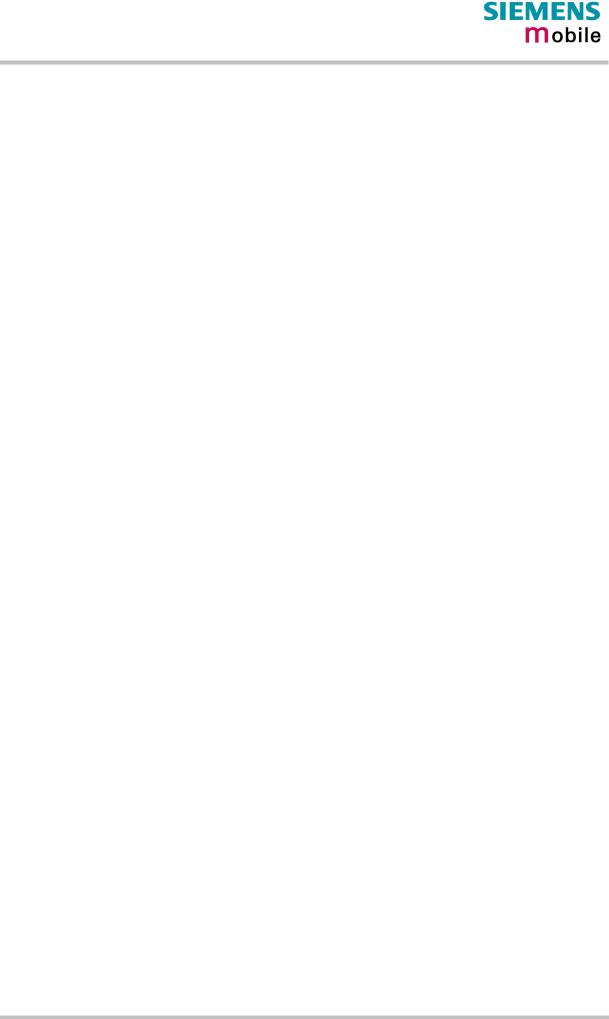
AT Command Set
1.3Conventions
Throughout the document, the GSM engines are referred to as ME (Mobile Equipment), MS (Mobile Station), TA (Terminal Adapter), DCE (Data Communication Equipment) or facsimile DCE (FAX modem, FAX board). When the Siemens product names are required to distinguish the two models, MC35 is short for the engine type and MC35T for the terminal.
To control your GSM engine you can simply send AT Commands via its serial interface. The controlling device at the other end of the serial line is referred to as TE (Terminal Equipment), DTE (Data Terminal Equipment) or plainly ´the application´ (probably running on an embedded system).
1.4AT command syntax
The "AT" or "at" prefix must be set at the beginning of each command line. To terminate a command line enter <CR>.
Commands are usually followed by a response that includes “<CR><LF><response><CR><LF>”. Throughout this document, only the responses are presented, <CR><LF> are omitted intentionally.
Table 2: Types of AT commands and responses
Test command |
AT+CXXX=? |
The mobile equipment returns the list of parameters and |
|
|
value ranges set with the corresponding Write command |
|
|
or by internal processes. |
Read command |
AT+CXXX? |
This command returns the currently set value of the pa- |
|
|
rameter or parameters |
Write command |
AT+CXXX=<...> |
This command sets user-definable parameter values. |
Execution command |
AT+CXXX |
The execution command reads non-variable parameters |
|
|
affected by internal processes in the GSM engine. |
|
|
|
1.4.1 Using parameters
Default parameters are underlined throughout this document.
Optional parameters are enclosed in square brackets. If optional parameters are omitted, the current settings are used until you change them.
Optional parameters or subparamters can be omitted unless they are followed by other parameters. If you want to omit a parameter in the middle of a string it must be replaced by a comma. Example:
AT+CPBW=,<number>,<type>,<text> writes a phonebook entry to the first free memory location. AT+CPBW=<index>,<number>,<type>,<text> writes a phonebook entry to the memory location specified by <index>.
When the parameter is a character string, e.g. <text> or <number>, the string must be enclosed in quotation marks, e.g. "Charlie Brown" or "+49030xxxx". Symbols within quotation marks will be recognized as strings.
All spaces will be ignored when using strings without quotaton marks.
It is possible to omit the leading zeros of strings which represent numbers.
In case of using V.25ter commands without giving an optional parameter, its value is assumed to be 0.
MC35_ATC_01_V05.00 |
Page 15 of 256 |
15.07.2002 |

AT Command Set
1.4.2 Combining AT commands on the same command line
You may enter several AT commands on the same line. This eliminates the need to type the "AT" or "at" prefix before each command. Instead, it is only needed once at the beginning of the command line. Use a semicolon as command delimiter.
The command line buffer accepts a maximum of 391 characters. If this number is exceeded none of the commands will be executed and TA returns ERROR.
The table below lists the AT commands you cannot enter together with other commands on the same line. Otherwise, the responses may not be in the expected order.
Table 3: Illegal combinations of AT commands
V.25ter commands |
With |
FAX commands, Prefix AT+F |
GSM 7.07 commands |
With |
Siemens commands, Prefix AT^S |
GSM 7.05 commands (SMS) |
--- |
To be used standalone |
Commands starting with AT& |
--- |
To be used standalone |
AT+IPR |
--- |
To be used standalone |
Note: When concatenating AT commands please keep in mind that the sequence of processing may be different from the sequential order of command input. Therefore, if the consecutive order of the issued commands is your concern, avoid concatenating commands on the same line.
1.4.3 Entering successive AT commands on separate lines
When you enter a series of AT commands on separate lines, leave a pause between the preceding and the following command until OK appears. This avoids sending too many AT commands at a time without waiting for a response for each.
MC35_ATC_01_V05.00 |
Page 16 of 256 |
15.07.2002 |

AT Command Set
1.5Supported character sets
The ME supports two character sets: GSM 03.38 (7 bit, also referred to as SMS alphabet) and UCS2 (16 bit, refer to ISO/IEC 10646). See Chapter 4.44 for information about selecting the character set. Character tables are provided in Chapter 9.5.
Due to the constraints described below it is recommended to prefer the USC2 alphabet in any external application.
If the GSM alphabet is selected all characters sent over the serial line are in the range from 0 ... 127.
CAUTION: GSM alphabet is not ASCII alphabet!
Several problems resulting from the use of the GSM alphabet:
1."@" character with GSM alphabet value 0 is not printable by an ASCII terminal program (e.g. Microsoft© Hyperterminal®).
2."@" character with GSM alphabet value of binary 0 will terminate any C string!
This is because the \0 is defined as C string end tag. Therefore, the GSM Null character may cause problems on application level when using a ´C´-function as „strlen()“. This can be avoided if it is represented by an escape sequence as shown in Table 4.
By the way, this may be the reason why even network providers often replace "@"with “@=*” in their SIM application.
3.Other characters of the GSM alphabet are misinterpreted by an ASCII terminal program. For example, GSM "ö" (as in "Börse") is assumed to be "|" in ASCII, thus resulting in "B|rse". This is because both alphabets mean different characters with values hex. 7C or 00 and so on.
4.In addition, decimal 17 and 19 which are used as XON/XOFF control characters when software flow control is activated, are interpreted as normal characters in the GSM alphabet.
When you write characters differently coded in ASCII and GSM (e.g. Ä, Ö, Ü), you need to enter escape sequences. Such a character is translated into the corresponding GSM character value and, when output later, the GSM character value can be presented. Any ASCII terminal then will show wrong responses.
Table 4: Character definitions depending on alphabet (examples)
GSM 03.38 |
GSM character |
Corresponding |
ASCII |
Hex |
|
|
character |
hex. value |
ASCII character |
Esc sequence |
Esc sequence |
||
Ö |
5C |
\ |
\5C |
5C |
35 |
43 |
" |
22 |
“ |
\22 |
5C |
32 |
32 |
ò |
08 |
BSP |
\08 |
5C |
30 |
38 |
@ |
00 |
NULL |
\00 |
5C |
30 |
30 |
CAUTION: Often, the editors of terminal programs do not recognize escape sequences. In this case, an escape sequence will be handled as normal characters. The most common workaround to this problem is to write a script which includes a decimal code instead of an escape sequence. This way you can write, for example, short messages which may contain differently coded characters.
MC35_ATC_01_V05.00 |
Page 17 of 256 |
15.07.2002 |
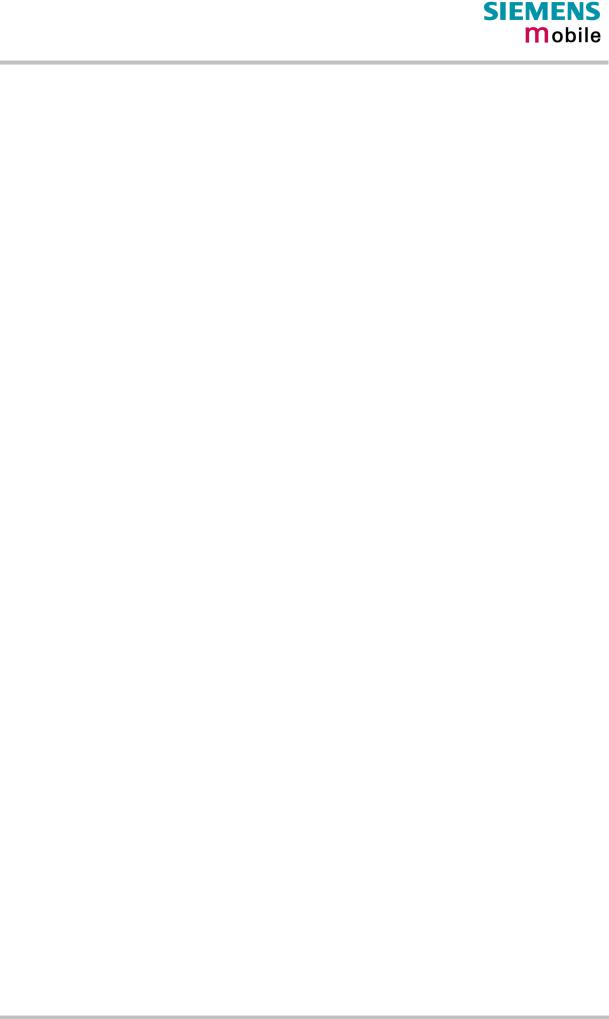
AT Command Set
1.6Flow control
Flow control is essential to prevent loss of data or avoid errors when, in a data or fax call, the sending device is transferring data faster than the receiving side is ready to accept. When the receiving buffer reaches its capacity, the receiving device should be capable to cause the sending device to pause until it catches up.
There are basically two approaches to regulate data flow: software flow control and hardware flow control. The High Watermark of the input / output buffer should be set to approximately 60% of the total buffer size. The Low Watermark is recommended to be about 30%. The data flow should be stopped when the capacity rises close to the High Watermark and resumed when it drops below the Low Watermark. The time required to cause stop and go results in a hysteresis between the High and Low Watermarks.
In Multiplex mode, it is recommended to use hardware flow control. For details please refer to [5].
1.6.1 Software flow control (XON/OFF flow control)
Software flow control sends different characters to stop (XOFF, decimal 19) and resume (XON, decimal 17) data flow. The only advantage of software flow control is that three wires would be sufficient on the serial interface.
1.6.2 Hardware flow control (RTS/CTS flow control)
Hardware flow control sets or resets the RTS/CTS wires. This approach is faster and more reliable, and therefore, the better choice. When the High Watermark is reached, CTS is set inactive until the transfer from the buffer has completed. When the Low Watermark is passed, CTS goes active once again.
To achieve smooth data flow, ensure that the RTS/CTS lines are present on your application platform. The application should include options to enable RTS/CTS handshake with the GSM engine. This needs to be done with the AT command AT\Q3 - it is not sufficient to set RTS/CTS handshake in the used Terminal program only.
The default setting of the GSM engine is AT\Q0 (no flow control) which must be altered to AT\Q3 (RTS/CTS hardware handshake on). The setting is stored volatile and must be restored each time after the GSM engine was switched off. For further details refer to Chapter 2.3.
AT\Q has no read command. To verify the current setting of AT\Q, simply check the settings of the active profile with AT&V.
Often, fax programs run an intialization procedure when started up. The intialization commonly includes enabling RTS/CTS hardware handshake, eliminating the need to set AT\Q3 once again. However, before setting up a CSD call, you are advised to check that RTS/CTS handshake is set.
RTS/CTS hardware handshake must also be set if you want to take advantage of the CYCLIC SLEEP modes. For further details refer to Chapter 4.11, AT+CFUN.
Note: After deactivating the RTS line, the ME may still send up to 32 bytes. This can be easily handled if the buffer of the host application is sufficiently sized, and if a hysteresis is implemented in its Rx buffer as mentioned in Chapter 1.6. A total buffer capacity of 256 bytes has been proved to work well.
MC35_ATC_01_V05.00 |
Page 18 of 256 |
15.07.2002 |

AT Command Set
2 Standard V.25ter AT Commands
These AT Commands are related to ITU-T (International Telecommunication Union, Telecommunication sector) V.25ter document.
MC35 supports the registers S0-S29. You can change S0,S3,S4,S5,S6,S7,S8,S10,S18 by using the appropriate ATSn commands. All the other registers are read-only and for internal usage only!
2.1A/ Repeat previous command line
Execute command Response
A/ |
Repeats previous command line. Line does not need to end with terminating |
|
character. |
|
Parameter |
|
|
Reference |
Note |
V.25ter |
After beginning with the character “a“ or „A“, a second character “t“ ,”T“ or “/“ |
|
has to follow. In case of using a wrong second character, it is necessary to |
|
start again with character “a“ or “A“. |
If autobauding is active (see +IPR, pg. 46) A/ (and a/) cannot be used.
2.2+++ Switch from data mode or PPP online mode to command mode
Execute command Response
+++This command is only available during a CSD call or a GPRS connection. The
+++ character sequence causes the TA to cancel the data flow over the AT interface and switch to command mode. This allows you to enter AT commands while maintaining the data connection to the remote device or, accordingly, the GPRS connection.
|
|
|
OK |
|
|
|
|
To prevent the +++ escape sequence from being misinterpreted as data, it must |
|
|
|
|
be preceded and followed by a pause of at least 1000 ms. The +++ characters |
|
|
|
|
must be entered in quick succession, all within 1000 ms. |
|
|
|
|
|
|
|
Reference |
|
Note: |
|
|
V.25ter |
|
To return from command mode to data or PPP online mode: Enter ATO as de- |
|
|
|
scribed in Chapter 2.17. |
|
|
|
|
|
|
|
|
|
|
|
|
MC35_ATC_01_V05.00 |
Page 19 of 256 |
15.07.2002 |

AT Command Set
2.3 AT\Qn Flow control
Execute command
AT\Q<n>
Response
OK
Parameter
<n> |
0 |
AT\Q0 |
No flow control |
|
1 |
AT\Q1 |
XON/XOFF software flow control |
|
2 |
AT\Q2 |
Only CTS by DCE |
|
3 |
AT\Q3 |
RTS/CTS hardware flow control |
|
|
|
Required for the following procedures: incoming |
or outgoing data calls, fax calls, GPRS connections, CYCLIC SLEEP modes set with AT+CFUN. Often, the initialization routine of Fax programs includes enabling RTS/CTS handshake, eliminating the need to issue AT\Q3 once again.
Reference Note
Line state refers to RS-232 levels.
The setting of AT\Q is stored volatile and must be restored each time after the GSM engine was switched off. Also, there is no way to store AT\Q to the user defined profile.
See also Chapter 1.6 for general information on flow control.
2.4 ATA Answer a call
Execute command
ATA
Reference
V.25ter
TA causes remote station to go off-hook (e.g. answer call).
Note1: Any additional commands on the same command line are ignored.
Note2: This command may be aborted generally by receiving a character during execution. It can´t be aborted in some connection setup states, such as handshaking.
Response
Response in case of data call, if successfully connected: CONNECT<text> TA switches to data mode.
Note: <text> output only if +ATX parameter setting with value > 0.
Response in case of voice call, if successfully connected:
OK
When TA returns to command mode after call release:
OK
Response if no connection:
NO CARRIER
Parameter
Note
See also AT+ATX and Chapter 9.1.5 for <text>
MC35_ATC_01_V05.00 |
Page 20 of 256 |
15.07.2002 |

AT Command Set
2.5 ATD Mobile originated call to dial a number
Execute command
ATD[<n>]
[<mgsm][;]
This command can be used to set up outgoing voice, data or fax calls. It also serves to control supplementary services.
Note:
The command may be aborted generally when receiving an ATH command during execution. It can´t be aborted in some connection setup states, such as handshaking.
Two different call setup options can be determined for voice calls: TA returns OK either after dialing was completed or after call has been established. Setting is made with AT^SM20 (see Chapter 8.18). In data connections, call setup always terminates when call has been established.
Response
If no dialtone (parameter setting ATX2 or ATX4):
NO DIALTONE
If busy (parameter setting ATX3 or ATX4):
BUSY
If a connection cannot be set up:
NO CARRIER
If successfully connected and non-voice call: CONNECT<text> TA switches to data state.
Note: <text> output only if +ATX parameter setting with value > 0.
When TA returns to command mode after call release:
OK
If successfully connected and voice call:
OK
Parameter
<n> String of dialling digits and optionally V.25ter modifiers (dialling digits): 0-9, * , #, +, A, B, C
V.25ter modifiers: these are ignored: ,(comma), T, P, !, W, @
Emergency call:
<n> = 112 worldwide number (no SIM needed)
<mgsm> String of GSM modifiers:
I Activates CLIR (disables presentation of own phone number to called party)
i Deactivates CLIR (enables presentation of own phone number to called party)
G Activate Closed User Group explicit invocation for this call only.
g Deactivate Closed User Group explicit invocation for this call only. <;> Only required to set up voice calls. TA remains in command mode.
MC35_ATC_01_V05.00 |
Page 21 of 256 |
15.07.2002 |
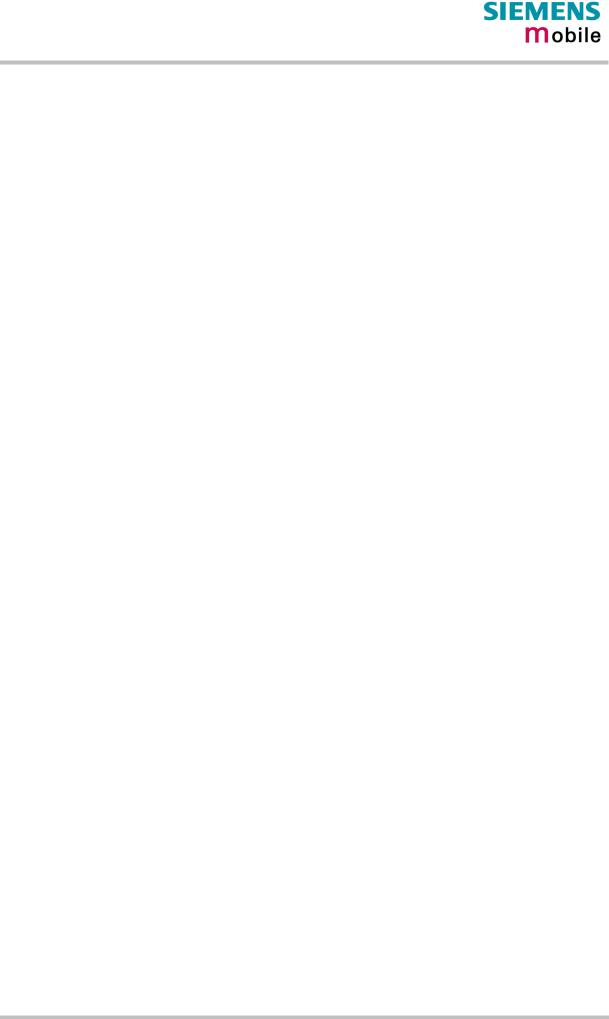
AT Command Set
Reference |
Note |
V.25ter/GSM |
Before setting up a data call, check that RTS/CTS handshake is enabled. See |
07.07 |
Chapters 1.6 and 2.3. |
|
Parameter ”l“ and ”i“ only if no *# code is within the dial string. |
|
<mgsm> is not supported for data calls. |
|
<n> is default for last number that can be dialled by ATDL. |
|
See also +ATX and chapter 9.1.5 for <text>. |
|
The *# codes can only be used with voice calls (i.e.if “;” is appended). |
|
If ATD is used with a USSD command (e.g. ATD*100#;) an AT+CUSD=1 is |
|
executed implicitly (see AT+CUSD, pg. 132). |
|
Parameter ‘G’ or ‘g’ will be ignored if Closed User Group was already activated, |
|
or accordingly, deactivated with AT+CCUG command. |
|
|
MC35_ATC_01_V05.00 |
Page 22 of 256 |
15.07.2002 |

AT Command Set
2.6ATD><mem><n> Originate call to phone number <n> in memory <mem>
This command allows you to dial a phone number from a specific phonebook. To initiate a call, enter a two letter abbreviation for the phonebook <mem>, followed by the memory location <n> of the desired entry. The location range of each phonebook can be queried by AT+CPBR (see Chapter 4.32).
Execute command
ATD><mem>
<n>[<mgsm>][;]
TA attempts to set up an outgoing call to the specified number.
Note: This command may be aborted generally by receiving a character during execution. Abortion is not possible during some states of connection setup such as handshaking.
Response
If error is related to ME functionality:
+CME ERROR: <err>
If no dialtone (parameter setting ATX2 or ATX4):
NO DIALTONE
If busy (parameter setting ATX3 or ATX4):
BUSY
If connection cannot be set up:
NO CARRIER
If successfully connected and non-voice call: CONNECT<text> TA switches to data state.
Note: <text> output only if +ATX parameter setting with value > 0.
When TA returns to command mode after call release:
OK
If successfully connected and voice call:
OK
Parameter
<mem> phonebook:
"SM” SIM phonebook (storage depending on SIM card) ”FD” SIM fixdialling phonebook (pos. 1-7)
”LD” SIM last-dialling-phonebook (usually the last 10 numbers dialed are stored on the SIM card, no matter whether or not the calls were successfully set up)
”MC” ME missed (unanswered received) calls list (up to 10 numbers) ”RC” SIM received calls list
”ME” ME Phonebook (up to 50 numbers)
”ON” SIM (or ME) own numbers (MSISDNs) list
Note: <mem> must be included in quotation marks (""), if parameter <mgsm> is used. If not, quotation marks are optional.
<n> |
Integer type memory location in the range of locations available in |
|
the selected memory, i.e. the index number returned by AT+CPBR. |
MC35_ATC_01_V05.00 |
Page 23 of 256 |
15.07.2002 |

AT Command Set
|
<mgsm> |
I |
Activates CLIR (disables presentation of own phone number to |
|
|
|
called party) |
|
|
i |
Deactivates CLIR (enables presentation of own phone number |
|
|
|
to called party) |
|
<;> |
Only required to set up voice calls. TA remains in command mode. |
|
|
|
|
|
Reference |
Note |
|
|
V.25ter/GSM |
There is no <mem> for emergency call (“EN”). |
||
07.07Command is not supported for data call!
Parameter <mgsm> only if no *# code is within the dial string.
The *#-codes can only be used with voice calls (i.e.if “;” is appended).
See also ATX and chapter 9.1.5 for <text>.
Example |
To query the location number of the phonebook entry: |
|
AT+CPBR=1,xx |
|
TA returns the entries available in the active phonebook. |
|
To dial a number from the SIM phonebook, for example the number stored to |
|
location 15: |
|
ATD>SM15; |
|
OK |
|
To dial a phone number stored in the last dial memory on the SIM card: |
|
ATD>LD9; |
|
OK |
|
|
MC35_ATC_01_V05.00 |
Page 24 of 256 |
15.07.2002 |

AT Command Set
2.7ATD><n> Originate call to phone number selected from active memory
This command can be used to dial a phone number selected from the active memory. The active memory is the phonebook selected with AT+CPBS (see Chapter 4.33). To set up a call simply enter the memory location of the desired entry. The memory location range of each phonebook can be queried by AT+CPBR (see Chapter 4.32).
|
Execute command |
TA attempts to set up an outgoing call to the stored number. |
|
|
|
|
ATD><n>[<mgsm>][;] |
Note: This command may be aborted generally by receiving a character |
|
||
|
|
during execution. It can´t be aborted in some connection setup states, |
|
||
|
|
such as handshaking. |
|
|
|
|
|
Response |
|
|
|
|
|
If error is related to ME functionality: |
|
|
|
|
|
+CME ERROR: <err> |
|
|
|
|
|
If no dialtone (parameter setting ATX2 or ATX4): |
|
|
|
|
|
NO DIALTONE |
|
|
|
|
|
If busy (parameter setting ATX3 or ATX4): |
|
|
|
|
|
BUSY |
|
|
|
|
|
If a connection cannot be set up: |
|
|
|
|
|
NO CARRIER |
|
|
|
|
|
If successfully connected and non-voice call: |
|
|
|
|
|
CONNECT<text> TA switches to data state. |
|
|
|
|
|
Note: <text> output only if +ATX parameter setting with value > 0. |
|
||
|
|
When TA returns to command mode after call release: |
|
|
|
|
|
OK |
|
|
|
|
|
If successfully connected and voice call: |
|
|
|
|
|
OK |
|
|
|
|
|
Parameter |
|
|
|
|
|
<n> |
integer type memory location should be in the range of locations |
|
|
|
|
|
available in the memory used, i.e. the index number returned by |
|
|
|
|
|
AT+CPBR. |
|
|
|
|
<mgsm> |
I Activates CLIR (disables presentation of own phone number to |
|
|
|
|
|
called party) |
|
|
|
|
|
i Deactivates CLIR (enables presentation of own phone number |
|
|
|
|
|
to called party) |
|
|
|
|
<;> |
Only required to set up voice calls. TA remains in command mode. |
|
|
|
|
|
|
|
|
|
Reference |
Note |
|
|
|
|
V.25ter/GSM 07.07 |
Parameter <mgsm> only if no *# code is within the dial string. |
|
|
|
|
|
Command is not supported for data call! |
|
|
|
|
|
The *# codes can only be used with voice calls (i.e.if “;” is appended). |
|
||
|
|
See also +ATX and chapter 9.1.5 for <text>. |
|
|
|
|
|
|
|
|
|
|
|
|
|
|
|
MC35_ATC_01_V05.00 |
|
Page 25 of 256 |
15.07.2002 |
||

AT Command Set
2.8ATD><str> Originate call to phone number in memory with corresponding field
This command searches the active phonebook for a given string <str> and dials the assigned phone number. The active phonebook is the one set with AT+CPBS.
Execute command |
TA attempts to set up an outgoing call to stored number |
|
ATD><str>[mgsm][;] |
Note: This command may be aborted generally by receiving a character dur- |
|
|
|
ing execution. It can´t be aborted in some connection setup states, |
|
|
such as handshaking. |
|
Response |
|
|
If error is related to ME functionality: |
|
|
+CME ERROR: <err> |
|
|
If no dialtone (parameter setting ATX2 or ATX4): |
|
|
NO DIALTONE |
|
|
If busy (parameter setting ATX3 or ATX4): |
|
|
BUSY |
|
|
If a connection cannot be set up: |
|
|
NO CARRIER |
|
|
If successfully connected and non-voice call: |
|
|
CONNECT<text> TA switches to data state. |
|
|
|
Note: <text> output only if +ATX parameter setting with value > 0. |
|
When TA returns to command mode after call release: |
|
|
OK |
|
|
If successfully connected and voice call: |
|
|
OK |
|
|
Parameter |
|
|
<str> |
string type value (“x”), which should equal an alphanumeric field in |
|
|
at least one phonebook entry in the searched memories; used char- |
acter set should be the one selected with AT+CSCS. <str> can contain escape sequences as described in Chapter 1.5.
<str> must be wrapped in quotation marks (""), if escape sequences or parameter <mgsm> are used or if the alphanumeric strings contains a blank. If not, quotation marks are optional.
<mgsm> I Activates CLIR (disables presentation of own phone number to called party)
iDeactivates CLIR (enables presentation of own phone number to called party)
<;> Only required to set up voice calls. TA remains in command mode.
Reference Note
V.25ter/GSM 07.07 Command is not supported for data calls! See also ATX and Chapter 9.1.5 for <text>
MC35_ATC_01_V05.00 |
Page 26 of 256 |
15.07.2002 |

AT Command Set
2.9ATDI Mobile originated call to dialable ISDN number <n>
Execute command
ATDI<n>[;]
Reference
V.25ter
TA attempts to set up an outgoing call to ISDN number.
Note: This command may be aborted generally by receiving a character during execution. This command cannot be aborted in some connection setup states, such as handshaking.
Response
If no dialtone (parameter setting ATX2 or ATX4):
NO DIALTONE
If busy (parameter setting ATX3 or ATX4):
BUSY
If a connection cannot be set up:
NO CARRIER
If successful connected and non-voice call:
CONNECT<text> TA switches to data state.
Note: <text> output only if +ATX parameter setting with value > 0.
When TA returns to command mode after call release:
OK
If successfully connected and voice call:
OK
Parameter |
|
<n> |
[+]<d> phone number |
|
string with maximum length of 20 characters |
+ |
international dialling format |
<d> |
ISDN number |
|
string of digits: +,0-9, A, B, C |
<;> |
voice call |
|
|
|
|
MC35_ATC_01_V05.00 |
Page 27 of 256 |
15.07.2002 |

AT Command Set
2.10 ATDL Redial last telephone number used
Execute command
ATDL[;]
Reference
V.25ter
This command redials the last voice and data call number used in the ATD command.
To redial the last data call number simply enter ATDL
To redial the last voice call number type ATDL;
Note: The command may be aborted generally by receiving a character during execution. This command cannot be aborted in some connection setup states, such as handshaking.
Response
If there is no last number or number is not valid:
+CME ERROR
If no dialtone (parameter setting ATX2 or ATX4):
NO DIALTONE
If busy (parameter setting ATX3 or ATX4):
BUSY
If a connection cannot be set up:
NO CARRIER
If successfully connected and non-voice call: CONNECT<text> TA switches to data state.
Note: <text> output only if +ATX parameter setting with value > 0.
When TA returns to command mode after call release:
OK
If successfully connected and voice call:
OK
Parameter
<;> |
voice call |
Note
In case of voice calls “;” is necessary.
MC35_ATC_01_V05.00 |
Page 28 of 256 |
15.07.2002 |

AT Command Set
2.11 ATE Enable command echo
Write command
ATE[<value>]
This setting determines whether or not the TA echoes characters received from TE during command state.
Response
OK
Parameter
<value> 0 Echo mode off 1 Echo mode on
Reference |
Note |
V.25ter |
In case of using the command without parameter, <value> is set to 0. |
|
|
2.12 ATH Disconnect existing connection
Execute command
ATH[n]
Reference
V.25ter
Disconnects any call in progress, such as voice, fax or CSD calls. See notes below for GPRS and multiplex mode.
Response
OK
Note:
OK is issued after circuit 109 (DCD) is turned off (RS-232 level), if it was previously on.
Parameter
<n> 0 terminate call
Note
Using ATH in Multiplex mode (AT+CMUX):
ATH terminates every voice, fax or CSD call, no matter on which channel ATH was executed.
For example, if ATH is executed on channel 2 or 3, a voice call made on channel 1 will be disconnected, too.
This behaviour is in accordance with ITU-T V.25 ter; (07/97, see “6.3.6 Hook control“: "ATH is terminating any call in progress").
Using ATH while GPRS is active during Multiplex mode:
ATH clears an active PDP context or terminates an existing PPP connection, but only if issued on the same logical channel where GPRS is used. It does not affect PDP contexts and PPP connections on other channels.
See also Chapter 6.3.2, ATH Manual rejection of a network request for PDP context activation.
MC35_ATC_01_V05.00 |
Page 29 of 256 |
15.07.2002 |

AT Command Set
2.13 ATI Display product identification information
Execute command Response
ATI
ME issues product information text
SIEMENS
MC35
REVISION xx.yy
OK
Explanation of “Revision“ parameter:
Version xx and variant yy of software release.
Reference Note
V.25ter
2.14 ATI[value] Display additional identification information
Execute command Response
ATI[value] |
<value>=9 delivers the following information. Other values are not supported and |
|
|
only return OK. |
|
|
ATI9 |
SIEMENS Gipsy Soft Protocolstack V2.550 |
|
|
MC35 |
Reference |
Note |
|
|
|
|
V.25ter
MC35_ATC_01_V05.00 |
Page 30 of 256 |
15.07.2002 |
